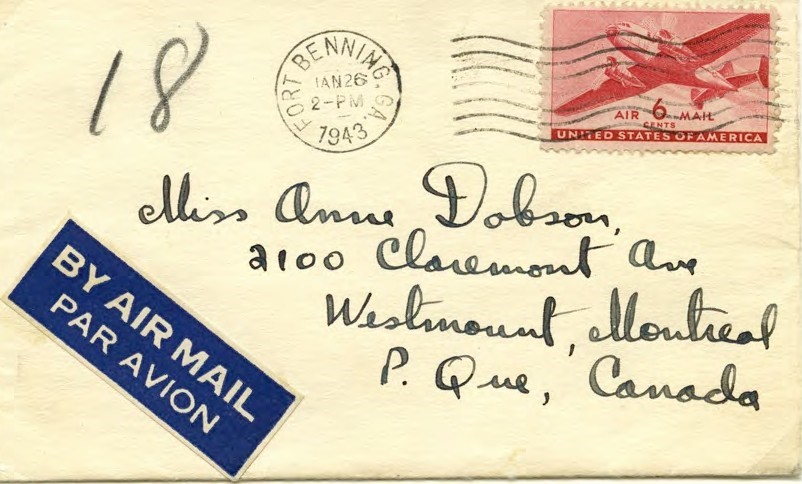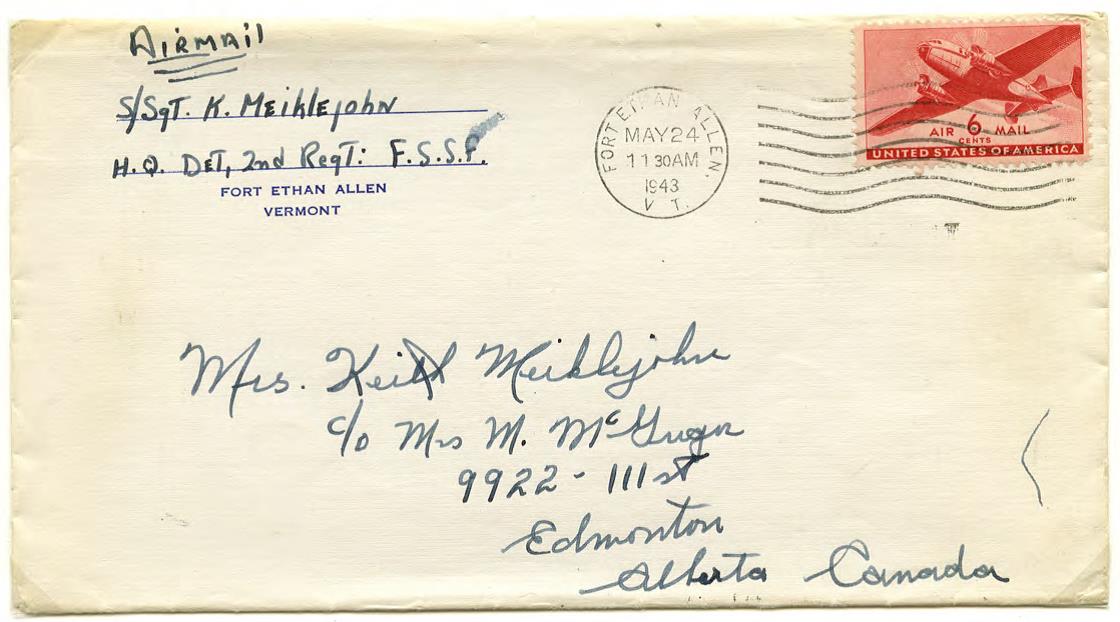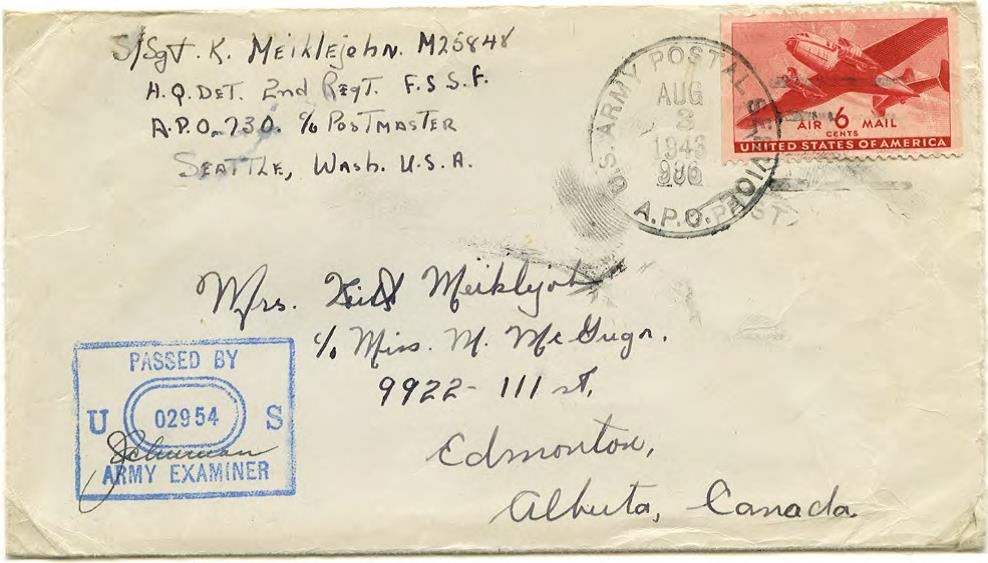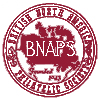First Special Service Force 1942 – 1944
Part 1 – North America
Ken Ellison
Early in 1942, Allied strategists were planning Operation Plough with the objective of destroying hydro-electric plants in Norway and Northern Italy as well as disabling the Romanian oil fields. This plan fell through, but it led to the formation of the joint USA-Canada First Special Service Force (also known as the Devil's Brigade and the Black Devils).

F.S.S.F. shoulder patch
The unit consisted of a combat force of three small regiments of which Canadians comprised one third of the strength. In addition there was a service battalion attached. The Canadian part, for security reasons, was initially called the 2nd Canadian Parachute Battalion until May of 1943 when the name was changed to the 1st Canadian Special Service Battalion when, in fact, they were an integral part of the joint First Special Service Force.
In August 1942, training started at Fort William Henry Harrison near Helena, Montana. The Force’s first ‘action’ was in the Kiska campaign of August 1943. By November, the F.S.S.F. was in Italy and in August 1944, in southern France. The Force was disbanded in December 1944 with the Canadians going to the 1st Canadian Corps, or the 1st Canadian Parachute Battalion as their training dictated while the Americans became part of the United States Army’s 474th Infantry Regiment in France.
Postal service for the F.S.S.F. was provided by the U.S. Army Postal Service and covers have been noted from APO 986 (Amchitka, Alaska), APO 700 (Oran, Algeria), APOs 306 and 541 (Caserta, Italy), APO 539 (Naples), APO 543 (Capua), APO 392 (Naples) and APOs 548 and 21 (Marseille, France).
The First Special Service Force covers in the illustrations that follow are from its Canadian members. The covers show usage from all points where the F.S.S.F. served in its span from 1942 to 1944. While the covers will look very similar, they are all identifiable by their cancellations, and each one helps to tell the story of the Force.
First Canadian Parachute Battalion – Fort Benning, Georgia
26 January 1943
The First Canadian Parachute Battalion was formed in July 1942 as an elite force with officers and NCO’s selected from many Canadian army units. Training of the early recruits was at the United States army’s parachute training school at Fort Benning, Georgia. Subsequent training of later parachutists was undertaken at Camp Shilo in Manitoba.
This cover was posted from one of the early Canadian trainees at Fort Benning on 26 January 1943.

Fort William Henry Harrison – Helena, Montana
14 March 1943
This cover was mailed from Fort William Henry Harrison at Helena, Montana, on 14 March 1943, where the First Special Service Force was in training. At this time, the Canadian element was known as the 2nd Canadian Parachute Battalion for security reasons. It was later, in May of 1943, referred to as the 1st Canadian Special Service Battalion, a convenient administrative label for the Canadian part of this combined force.
All members qualified as parachutists initially and this aspect was followed with intensive ground and winter warfare training.

Fort Ethan Allen – Burlington, Vermont
24 May 1943
On the completion of training in Montana, the First Special Service Force moved to the eastern States. This cover of 24 May 1943 shows the Force to be at Fort Ethan Allen where the Canadian component was using its proper name, F.S.S.F.
On 15 April 1943, the Force started amphibious training at Camp Bradford, Norfolk, Virginia, from whence they moved to Fort Ethan Allen, arriving there about the 20 May. They left this camp on 26 June for San Francisco.

A.P.O. 986 – Amchitka, Alaska
31 July 1943
The First Special Service Force left San Francisco on 11 July 1943 bound for Amchitka. This cover of 31 July 1943 was posted soon after the Force’s arrival at Amchitka.
At Amchitka, the Force underwent further intensive amphibious training in preparation for the attack on Kiska in the Aleutian Islands.

A.P.O. 986 – Amchitka, Alaska
3 August 1943
This cover of 3 August 1943 was posted at the Amchitka Army Post Office during the Force’s training there. Here for about two weeks, the unit got acclimatized to the harsh environment of the Aleutian Islands where they expected Japanese resistance on a par with that given the United States Army earlier on Attu to the west.

A.P.O. 986 – Amchitka, Alaska
8 August 1943
At the time of the F.S.S.F.’s training on Amchitka, the regular element of the Canadian Army, 4,800 all ranks, was on its way there from Nanaimo and Courtenay, in British Columbia, in four United States troop transports.
This Special Services Force cover of 8 August 1943 shows the usual Army Post Office type marking with killer bars as well as the Censor’s handstamp and signature.

A.P.O. 986 – Amchitka, Alaska
9 August 1943
The First Special Service Force was composed of U.S. and Canadian specially trained ‘commando type’ troops. Formed and trained in the U.S., it came to Amchitka as the lead force in the Kiska invasion. Unlike the regular Canadian 13th Infantry Brigade, the F.S.S.F. was back in the U.S. by 1 September, having left Kiska four days after landing there.
This cover of 9 August 1943 was posted by a Canadian Force member on Amchitka Island, from U.S. A.P.O. 986. It bears the Type B.1 U.S. censor marking with an officer signature.

A.P.O. 986 – Amchitka, Alaska
18 August 1943
At the date of this cover, 18 August 1943, the F.S.S.F had been on the Kiska for three days. Since the Japanese enemy had already withdrawn, the Force was not needed, and, accordingly, they were back in the United States at San Francisco by 1 September where they were readied for the Mediterranean war theatre.

Fort Ethan Allen – Burlington, Vermont
26 September 1943
Coming straight from Kiska, via San Francisco, the Force went to Camp Ethan Allen where they regrouped and underwent further training. From here, they went to Camp Patrick Henry on the 19 October and on the 28th boarded the Empress of Scotland for the journey to North Africa.
This cover from a Canadian in the HQ Section of the 2nd Regiment, First Special Service Force, was posted on 26 September 1943, when the Force was readying for the trip overseas.

Fort Ethan Allen – Burlington, Vermont
23 October 1943
A change of address card from Fort Ethan Allen was filled out on 4 October 1943 and was postmarked by the camp machine cancellation on 23 October indicating it was held for security purposes as the troops were soon to be in transit. The Force left for overseas on 28 October.
Both sides of the card are shown.


A.P.O. 4994, c/o P.M. New York
27 October 1943
This letter with the unnumbered A.P.O. cancellation was written at Camp Patrick Henry, Virginia, where the Force was soon to board the transport Empress of Scotland for North Africa.
The letter, postmarked on 27 October 1943, was mailed on the eve of the F.S.S.F.’s departure
for overseas.

Copyright © 2019 Ken Ellison
Web design copyright © 2013-2025 The British North America Philatelic Society.
The documents on this website are for informational and non-commercial or personal use only.
Documents on this website shall not be used on other websites or for commercial purposes without permission.
This page was last modified on 2021-11-04
